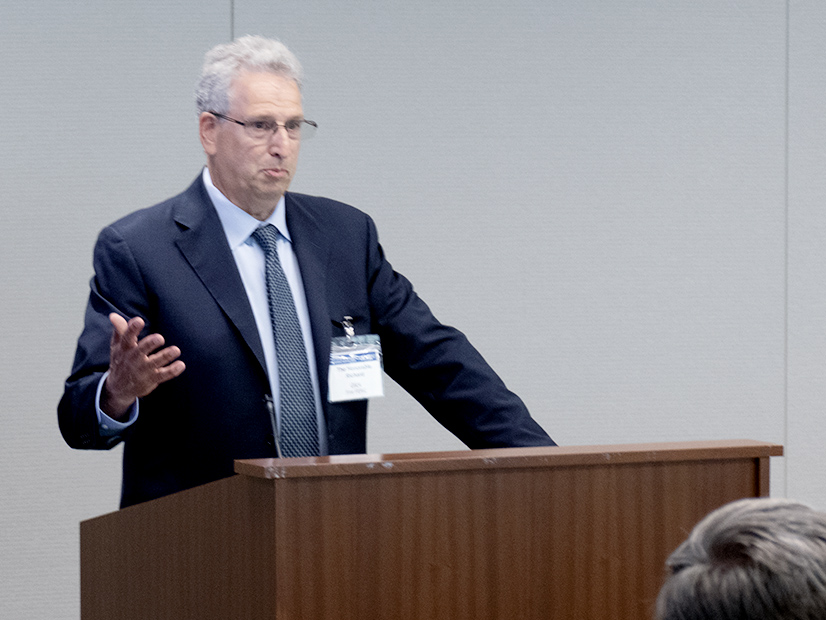
WASHINGTON — Giving FERC a larger role in transmission siting would aid decarbonization and grid reliability, but it is unclear whether Congress will have the appetite for that any time soon, former FERC Chair Richard Glick told the Energy Bar Association’s Electricity Steering Committee on Tuesday.
Permitting “reform” has been a hot topic on Capitol Hill this session, and Congress’ debt ceiling agreement included provisions to shorten reviews under the National Environmental Policy Act. (See Lawmakers, White House Promise More Work on Permitting After Debt Deal.)
But the changes “weakened the legislative momentum,” making it much more difficult to find a legislative vehicle for giving FERC increased powers this year, said Glick, a former Senate aide who opened a consulting shop after his term at FERC expired. (See Former FERC Chair Richard Glick Sets up Consulting Shop.)
He noted that the Infrastructure Investment and Jobs Act gave FERC authority to overrule state denials of transmission lines designated by the Department of Energy as National Interest Electricity Transmission Corridors. (See FERC Backstop Siting Proposal Runs into Opposition from States.)
“I think there’s still going to be issues with regard to transmission siting [for] certain lines,” Glick said. “Certainly, it’s not going to happen as quickly as it might have happened, because there’s no one-stop-shopping, so to speak, at FERC.”
The current system of leaving most siting decisions up to states might have made sense for many decades, he said. But with major transmission lines needed to bring renewables across multiple states, or to increase minimum transfer capability among regions to deal with increasingly volatile weather, the current system needs to change, he said.
Rights of First Refusal
Glick and other speakers at the EBA meeting also weighed in on FERC’s controversial proposal to reinstate a federal right of first refusal (ROFR) on transmission construction for incumbent utilities that work with a partner. The change was included in the commission’s April 2022 Notice of Proposed Rulemaking on transmission planning, which Glick supported (RM21-17). (See ANALYSIS: FERC Giving up on Transmission Competition?)
FERC Order 1000 in 2011 eliminated the federal ROFR on regional transmission projects. Glick said he supported reinstating the ROFR because utilities responded to Order 1000 by reducing spending on bigger regional projects in favor of local transmission that remained exempt from competition.
“The answer that I first thought when I was at FERC was why not just subject all of them to competition?” Glick recounted. “And staff convinced me that wasn’t a workable solution.”
Glick acknowledged it was hard to police local transmission projects that often fall under formula rates and have varying levels of state oversight. FERC Commissioner Mark Christie has suggested getting rid of formula rates when states lack the ability to adequately oversee such local lines.
“The states that don’t have that [oversight] authority would quickly act to get that authority because getting rid of formula rates would be complex — and that’s an understatement,” Glick said.
Some states reacted to Order 1000 by imposing ROFRs on any transmission line that goes through their territory. LS Power Development Senior Vice President Sharon Segner said it is an open legal question whether such laws “invade” FERC’s exclusive jurisdiction over interstate transmission.
A group of MISO transmission customers filed a complaint last year asking FERC to effectively override such state laws (EL22-78). (See Consumer Groups File FERC Complaint Against MISO.)
“They interfere with interstate commerce,” Segner said. “And we’re talking about states interfering with regional projects that are paid for by citizens outside of the state, yet you have state protectionist laws coming into play.”
WIRES Executive Director Larry Gasteiger holds the opposite opinion on ROFRs, contending that FERC’s NOPR would get more interregional transmission built.
“Our general approach to ROFR and to competitive transmission issues comes from the standpoint of … how is it impacting transmission development and the ability to get transmission developed in a timely basis?” Gasteiger said.
More than a decade after FERC introduced competition to transmission, the policy does not seem to be working and is producing results that go against other transmission policies that FERC and others support, he said. Competition makes it more difficult to build the huge amount of transmission that is forecasted as needed to get the grid to net zero emissions, he added.
“It’s taken us over 100 years to get to where we are now,” Gasteiger said. “So, you’re talking about doubling or tripling that amount of transmission in a third of the time.”
Gasteiger argued that it made sense to keep local projects away from competition because often they are needed quickly and are often fairly small — such as the need to raise a substation to avoid floodwaters.
Segner said LS Power does not want to compete with incumbent utilities on such projects. But she said local transmission lines of 100 kV or above should be open to competition.
Making that many lines open to competition would lead to even more states passing their own ROFR laws, said Perkins Coie Partner Jane Rueger. But major interregional lines could benefit from competitive processes, she said.
Major transmission lines that cross states are often built by one company, but those efforts could run into a state ROFR law that blocks them from getting built.
“You might see more pressure to have a federal solution, so again, that everything is rowing in the same direction,” Rueger said.

